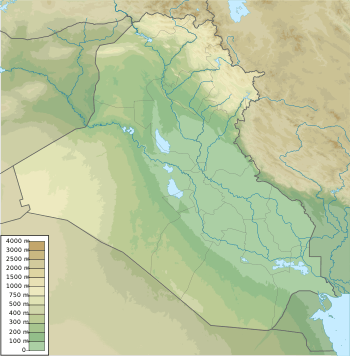Tell el-'Oueili
Tell el-'Oueili is a tell, or ancient settlement mound, located in Dhi Qar Governorate, southern Iraq. The site was excavated between 1976 and 1989 by French archaeologists under the direction of Jean-Louis Huot. The excavations have revealed occupation layers predating those of Eridu, making Tell el-'Oueili the earliest known human settlement in southern Mesopotamia.
 Shown within Iraq | |
| Location | Iraq |
|---|---|
| Region | Dhi Qar Governorate |
| Coordinates | 31.243°N 45.885°E |
| Type | settlement |
| Length | 200 metres (660 ft) |
| Height | 5 metres (16 ft) |
| History | |
| Founded | 6500-5400 BCE |
| Abandoned | before 3000 BCE |
| Periods | Ubaid |
| Site notes | |
| Excavation dates | 1976, 1978, 1981, 1983, 1985, 1987, 1989 |
| Archaeologists | A. Parrot. J.-L. Huot |
History of research
The site was first noted and surveyed by French scholar André Parrot, who at the time was working at nearby Larsa.[1] Two small excavation seasons took place in 1976 and 1978, and regular excavations commenced in 1981.[2] Four more seasons took place in every uneven year until 1989. All excavations were directed by French archaeologist Jean-Louis Huot.[3]
Tell el-'Oueili and its environment
The site measures 200 metres (660 ft) in diameter and is approximately 5 metres (16 ft) high.[1] It is located ca. 3.5 kilometres (2.2 mi) southeast of Larsa in Dhi Qar Governorate, southern Iraq. The environment of 'Oueili is characterized by temperatures that can reach more than 50 °C in summer and less than 250 mm of annual rainfall, making the area unsuitable for rainfed agriculture.[4]
Occupation history
Tell el-'Oueili was occupied during the Ubaid period. The excavations have revealed occupation layers dating from Ubaid 0 (6500-5400 BCE) to Ubaid 4. The phase Ubaid 0 was first discovered at this site and was hence provisionally termed 'Oueili-phase.[2]
Relative chronology
See also
References
- Huot, J.-L. (1980), "Tell el'Oueili (Iraq): les Premiers Résultats", Paléorient (in French), 6 (1): 207–211, doi:10.3406/paleo.1980.4270
- Huot, J.-L. (1985), "Tell el'Oueili. Principaux Résultats de la Quatrième Campagne (1983)", Paléorient (in French), 11 (1): 119–123, doi:10.3406/paleo.1985.4367
- Vallet, R.; Huot, J.-L. (1990), "Les Habitations à salles hypostyles d'époque Obeid 0 de Tell El'Oueili", Paléorient (in French), 16 (1): 125–130, doi:10.3406/paleo.1990.4527
- Huot, J.-L. (1985a), "Travaux en basse Mésopotamie. Les fouilles françaises à Larsa et 'Oueili", Comptes-rendus des Séances de l'Académie des Inscriptions et Belles-Lettres (in French), 129 (2): 300–318, doi:10.3406/crai.1985.14270
- Liverani, Mario (2013). The Ancient Near East: History, Society and Economy. Routledge. p. 13, Table 1.1 "Chronology of the Ancient Near East". ISBN 9781134750917.
- Shukurov, Anvar; Sarson, Graeme R.; Gangal, Kavita (7 May 2014). "The Near-Eastern Roots of the Neolithic in South Asia". PLOS ONE. 9 (5): e95714. Bibcode:2014PLoSO...995714G. doi:10.1371/journal.pone.0095714. ISSN 1932-6203. PMC 4012948. PMID 24806472.
- Bar-Yosef, Ofer; Arpin, Trina; Pan, Yan; Cohen, David; Goldberg, Paul; Zhang, Chi; Wu, Xiaohong (29 June 2012). "Early Pottery at 20,000 Years Ago in Xianrendong Cave, China". Science. 336 (6089): 1696–1700. Bibcode:2012Sci...336.1696W. doi:10.1126/science.1218643. ISSN 0036-8075. PMID 22745428.
- Thorpe, I. J. (2003). The Origins of Agriculture in Europe. Routledge. p. 14. ISBN 9781134620104.
- Price, T. Douglas (2000). Europe's First Farmers. Cambridge University Press. p. 3. ISBN 9780521665728.
- Jr, William H. Stiebing; Helft, Susan N. (2017). Ancient Near Eastern History and Culture. Routledge. p. 25. ISBN 9781134880836.